Contents
- 1 Delhi City Tour
- 2 The Red Fort, Delhi: Unveiling India’s Historical Gem
- 3
- 4 Qutub Minar: A Marvel of Indo-Islamic Architecture
- 5 Humayun’s Tomb: A Marvel of Mughal Architecture
- 6 Historical Background & Architectural Splendor
- 7 Layout and Features
- 8 Cultural Significance
- 9 Visiting Humayun’s Tomb
- 10 India Gate, Delhi: A Symbol of Remembrance and Pride
- 11 Historical Significance
- 12 Architecture and Design
- 13 Visiting India Gate
- 14 Jama Masjid Delhi: A Magnificent Marvel of Islamic Architecture
- 15 Historical Significance
- 16 Architectural Grandeur
- 17 Religious Significance
- 18 Visiting Jama Masjid
- 19 Lotus Temple a flower-inspired design
- 20 Architectural Marvel
- 21 Spiritual Significance
- 22 Open to All
- 23 Garden and Surroundings
- 24 Visiting the Lotus Temple
- 25 Akshardham Temple or Swaminarayan Akshardham
- 26 History and Architecture
- 27 Key Attractions
- 28 Timings and Visiting Details
- 29 Significance
- 30 How to Reach
- 31 Rashtrapati Bhavan: The Presidential Residence of India
Delhi City Tour
Delhi City Tour will take you to the rich history, culture, and iconic landmarks of this Delhi. Discover ancient monuments, bustling markets, and a tapestry of traditions on your unforgettable journey through Delhi.
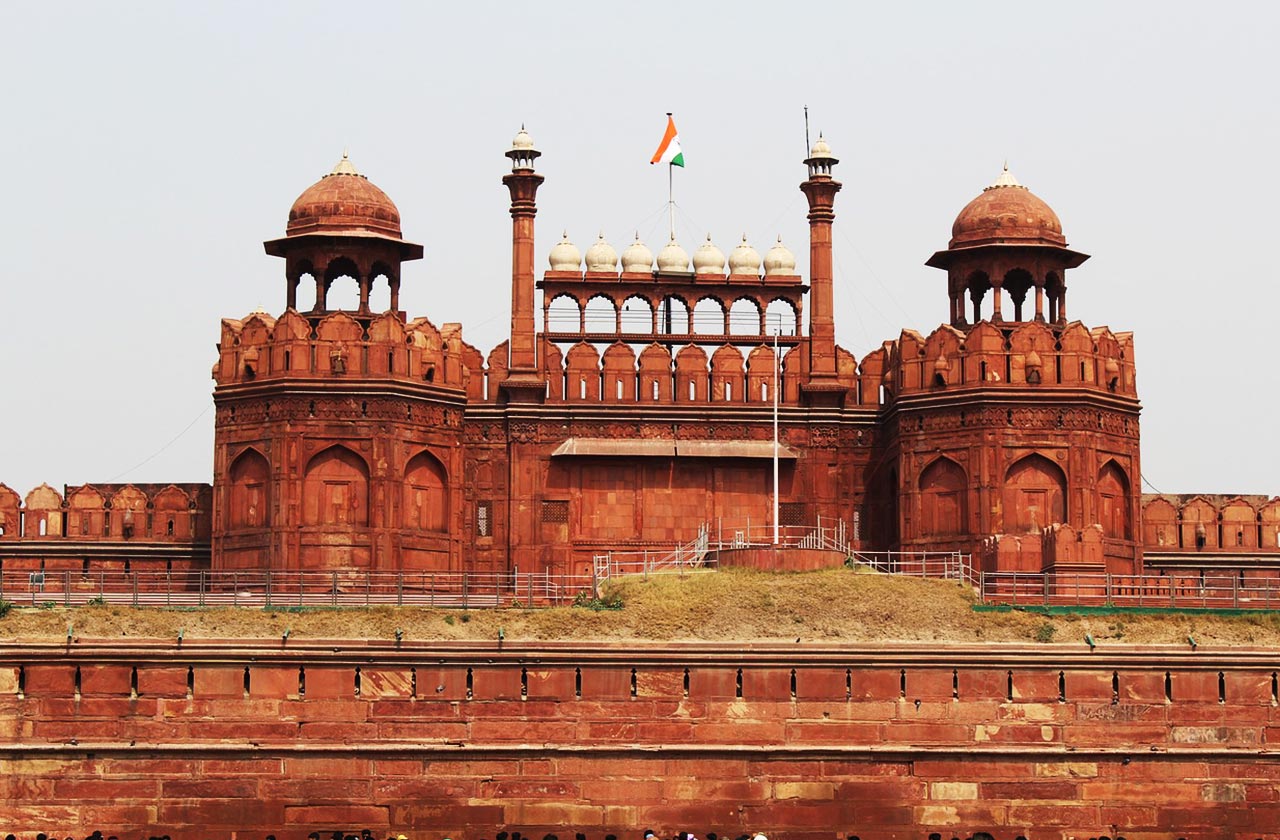
The Red Fort, Delhi: Unveiling India’s Historical Gem
The Red Fort, also known as “Lal Qila” in Hindi, is a grandiose monument located in the heart of Delhi, India. This iconic fortress stands as a testament to India’s rich history, serving as a symbol of power, resilience, and architectural marvel. In this article, we’ll delve into the full details of the Red Fort, offering a comprehensive understanding of its historical significance, architectural splendor, and its place in modern India.
Historical Significance:
The Red Fort holds immense historical significance, making it one of the most revered landmarks in India. It was built by the Mughal Emperor Shah Jahan in the mid-17th century, between 1638 and 1648, as a fortified palace and the new capital of the Mughal Empire. The fort served as the main residence of the Mughal emperors for around 200 years.
One of the most memorable historical events associated with the Red Fort is the declaration of India’s independence on August 15, 1947. Jawaharlal Nehru, India’s first Prime Minister, delivered his historic “Tryst with Destiny” speech from the Red Fort, marking the end of British colonial rule and the beginning of a new era for India.
Architectural Marvel:
The Red Fort is a true architectural masterpiece, blending Mughal, Persian, and Indian architectural styles. The fort is made primarily of red sandstone, which gives it its distinctive color and name. The intricate carvings, delicate inlay work, and the meticulous planning that went into its construction are awe-inspiring.
Notable architectural features of the Red Fort include:
- Diwan-i-Aam: The Hall of Public Audience, where the emperor would address the common people.
- Diwan-i-Khas: The Hall of Private Audience, a place for private meetings and discussions.
- Rang Mahal: The Palace of Colors, adorned with beautiful frescoes and a central water channel for cooling the air.
- Moti Masjid: The Pearl Mosque, a pristine white marble mosque located within the fort complex.
Modern-Day Importance:
Today, the Red Fort is not just a historical relic but a living testament to India’s cultural and historical heritage. It has been recognized as a UNESCO World Heritage Site, further solidifying its importance on a global scale.
Visitors to the Red Fort can explore its various structures, gardens, and museums that provide a glimpse into India’s storied past. The annual Independence Day celebrations, where the Prime Minister raises the Indian flag and delivers a speech from the Red Fort, are watched by millions both within India and around the world.
In conclusion, the Red Fort is a beacon of India’s history, culture, and resilience. It stands as a testament to the architectural prowess of the Mughal Empire and continues to be a source of national pride. A visit to the Red Fort is a journey through time, allowing visitors to immerse themselves in the grandeur and significance of this magnificent fortress.
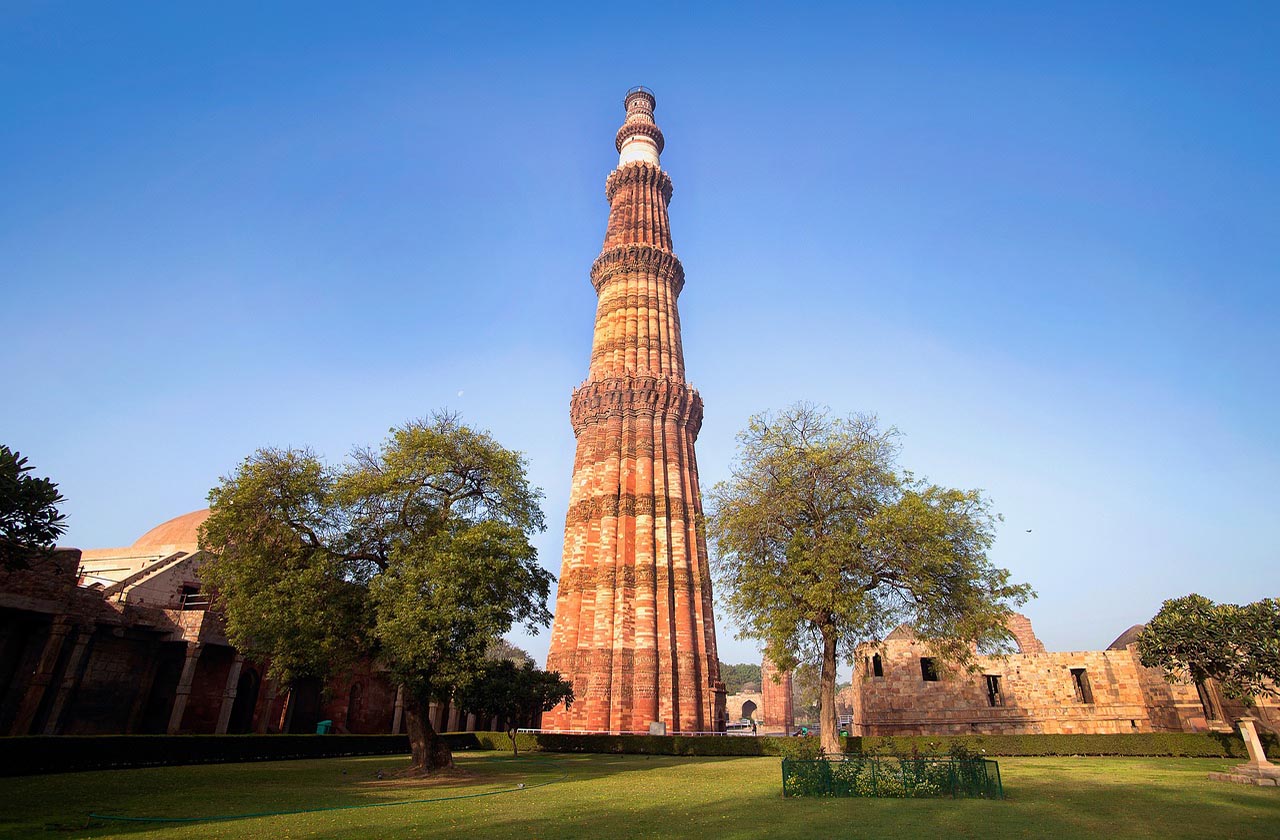
Qutub Minar: A Marvel of Indo-Islamic Architecture
The Qutub Minar is a towering masterpiece of Indo-Islamic architecture located in Delhi, India. This iconic monument is not only one of the most famous landmarks in Delhi but also a UNESCO World Heritage Site. Let’s explore the rich history, intricate design, and cultural significance of this remarkable structure.
Historical Background
The Qutub Minar was built during the early 13th century and is an integral part of the Qutb Complex, a group of monuments that includes several other historically significant structures. Its construction was initiated by Qutb-ud-din Aibak, the founder of the Delhi Sultanate, and was later completed by his successors, including Iltutmish.
Architectural Marvel
- Height: The Qutub Minar stands at an impressive height of 73 meters (240 feet), making it one of the tallest brick minarets in the world. It consists of five distinct stories, each adorned with intricate architectural details.
- Design: The minaret is constructed primarily of red sandstone and marble, with verses from the Quran inscribed in beautiful calligraphy. The architecture reflects a fusion of Indo-Islamic and Afghan styles, creating a unique and visually striking monument.
- Spiral Staircase: Inside the Qutub Minar, there is a spiral staircase with 379 steps, which allows visitors to climb to the top. The staircase is not open to the public due to safety concerns but offers a view of the intricate details of the structure.
Significance
The Qutub Minar holds great historical and cultural significance:
- Cultural Symbolism: This minaret is a testament to the cultural diversity and architectural prowess of medieval India. It represents the beginning of Indo-Islamic architecture, which would go on to influence the construction of many other iconic monuments in the Indian subcontinent.
- Victory Tower: Originally, the Qutub Minar was intended to be a victory tower, commemorating the triumph of the Delhi Sultanate over its adversaries. It was meant to serve both religious and political purposes.
Visiting Qutub Minar
The Qutub Minar is open to the public and is a popular tourist attraction in Delhi. Visitors can explore the entire Qutb Complex, which includes the minaret, the Quwwat-ul-Islam Mosque, the Alai Darwaza, and the Iron Pillar.
- Location: The Qutub Minar is located in the Mehrauli area of South Delhi.
- Timings: It is open for visitors from sunrise to sunset, and it is advisable to visit in the early morning or late afternoon to avoid the crowds and enjoy the best lighting for photography.
- Entry Fee: There is an entry fee for both Indian and foreign tourists, with different rates for adults and children.
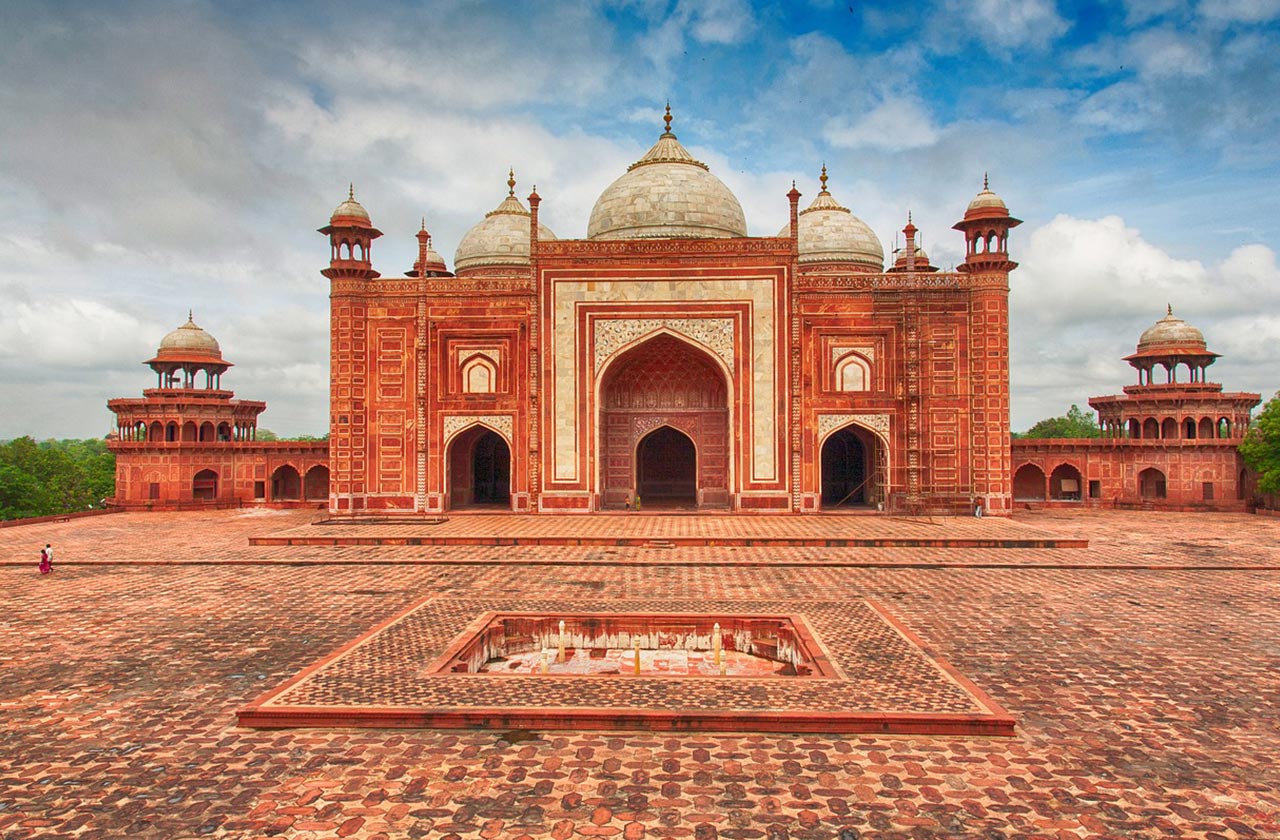
Humayun’s Tomb: A Marvel of Mughal Architecture
Humayun’s Tomb, located in the heart of Delhi, is one of the city’s most iconic and historically significant monuments. This architectural masterpiece is not only a UNESCO World Heritage Site but also a testament to the grandeur of the Mughal Empire. In this article, we will explore the rich history, intricate architecture, and cultural significance of Humayun’s Tomb.
Historical Background & Architectural Splendor
Humayun’s Tomb was built in the mid-16th century, between 1565 and 1572, by Haji Begum, the widow of Mughal Emperor Humayun. The tomb was constructed as a final resting place for the emperor and also to commemorate his legacy. It marked a significant shift in Mughal architectural style and served as an inspiration for later Mughal monuments, including the Taj Mahal.
Persian and Mughal Fusion
One of the most striking features of Humayun’s Tomb is its unique architectural style, which blends Persian and Mughal influences. The tomb is an excellent example of the Charbagh (four gardens) layout, a Persian garden style that was adapted by the Mughals. It is surrounded by lush gardens and intricate water channels, creating a serene and harmonious environment.
Red Sandstone and White Marble
The main tomb structure is made of red sandstone, while the dome and intricate details are crafted from white marble. The combination of these materials adds to the monument’s visual appeal, creating a stark contrast that is both elegant and majestic.
Double-Dome Structure
The central dome of Humayun’s Tomb is a double-dome structure, a notable architectural feature that sets it apart from earlier Mughal tombs. This innovation allowed for greater height and grandeur, and it became a defining characteristic of Mughal architecture.
Layout and Features
Charbagh Garden
The tomb is situated at the center of a vast Charbagh, a Persian-style garden divided into four quadrants. The garden is meticulously planned, with geometric pathways and water channels. It symbolizes the paradise garden described in the Quran and serves as a serene backdrop to the tomb.
Main Tomb Chamber
The main tomb chamber houses the cenotaph of Emperor Humayun. Visitors can explore the interior, which is adorned with intricate calligraphy and geometric designs. It’s a beautiful representation of Mughal artistry.
Isa Khan’s Tomb
Within the complex, you will also find the tomb of Isa Khan, an Afghan noble and a contemporary of Emperor Sher Shah Suri. This tomb predates Humayun’s Tomb and offers a glimpse into the architectural style of that era.
Cultural Significance
Humayun’s Tomb holds immense cultural and historical significance. It not only marks the resting place of an important Mughal emperor but also reflects the architectural prowess of the Mughals. The tomb’s design and layout have had a profound influence on subsequent Mughal architecture, including the construction of the Taj Mahal.
Visiting Humayun’s Tomb
Today, Humayun’s Tomb is a popular tourist destination in Delhi. Visitors can explore the gardens, admire the architectural details, and learn about the history of the Mughal Empire. It’s a place where history and beauty converge, making it a must-visit attraction for anyone interested in India’s rich heritage.
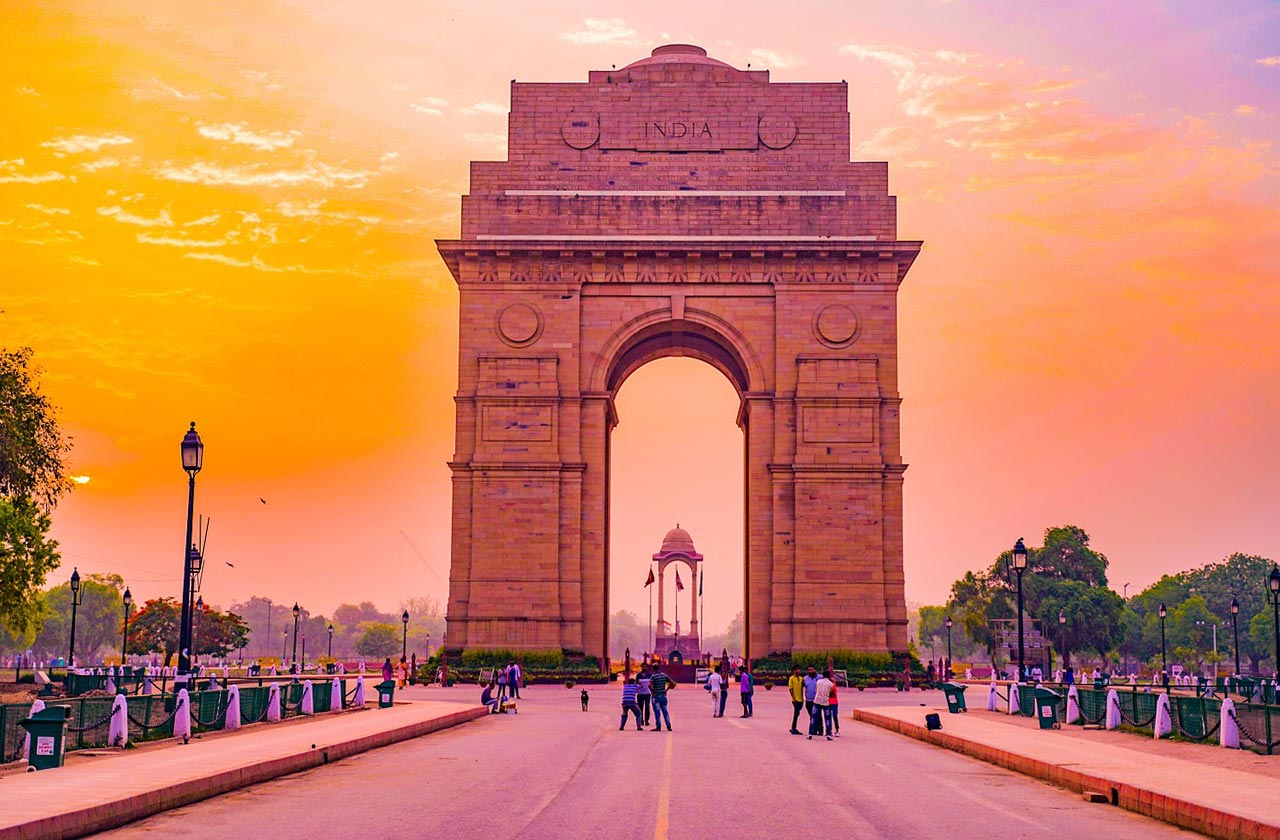
India Gate, Delhi: A Symbol of Remembrance and Pride
India Gate is an iconic monument located in the heart of New Delhi, India. This majestic structure stands as a symbol of remembrance and pride, commemorating the sacrifices of Indian soldiers who laid down their lives during World War I. In this comprehensive guide, we will delve into the rich history, architecture, and significance of India Gate.
Historical Significance
World War I Memorial
India Gate was originally constructed as the “All India War Memorial” to honor the 70,000 Indian soldiers who perished in the First World War, particularly during the campaigns in Mesopotamia, Persia, and East Africa. Their names are inscribed on the monument’s walls, a poignant reminder of their sacrifices.
Amar Jawan Jyoti
Beneath the arch of India Gate lies the Amar Jawan Jyoti, the “Flame of the Immortal Soldier.” This eternal flame was added after India’s independence in 1971 and serves as a tribute to the Indian soldiers who sacrificed their lives in the 1971 Indo-Pak War.
Architecture and Design
Inspiration from Triumphal Arches
India Gate’s design is heavily influenced by the triumphal arches of Europe. The monument was designed by Sir Edwin Lutyens, one of the leading architects of New Delhi’s city planning during the British colonial era. It is often compared to the Arc de Triomphe in Paris.
Architectural Elements
- Height: India Gate stands at an impressive height of 42 meters (138 feet) and is constructed from pale red and yellow sandstone.
- Inscriptions: The names of the soldiers who sacrificed their lives during World War I are inscribed on the walls of India Gate.
- Canopy: At the top of the arch, there is a canopy that was added in later years. This canopy used to house a statue of King George V, which has since been removed.
- Amar Jawan Jyoti: As mentioned earlier, the Amar Jawan Jyoti is an essential part of India Gate’s design, with the burning flame symbolizing the eternal spirit of the immortal soldier.
Visiting India Gate
India Gate is not just a historical monument; it’s also a popular spot for locals and tourists. The monument is beautifully illuminated at night, making it an excellent place for an evening stroll. The well-maintained lawns around India Gate offer a perfect spot for a picnic or leisurely relaxation.
Additionally, the area around India Gate is also home to several other attractions, including the National Gallery of Modern Art, Rashtrapati Bhavan (the President’s House), and the Parliament House.
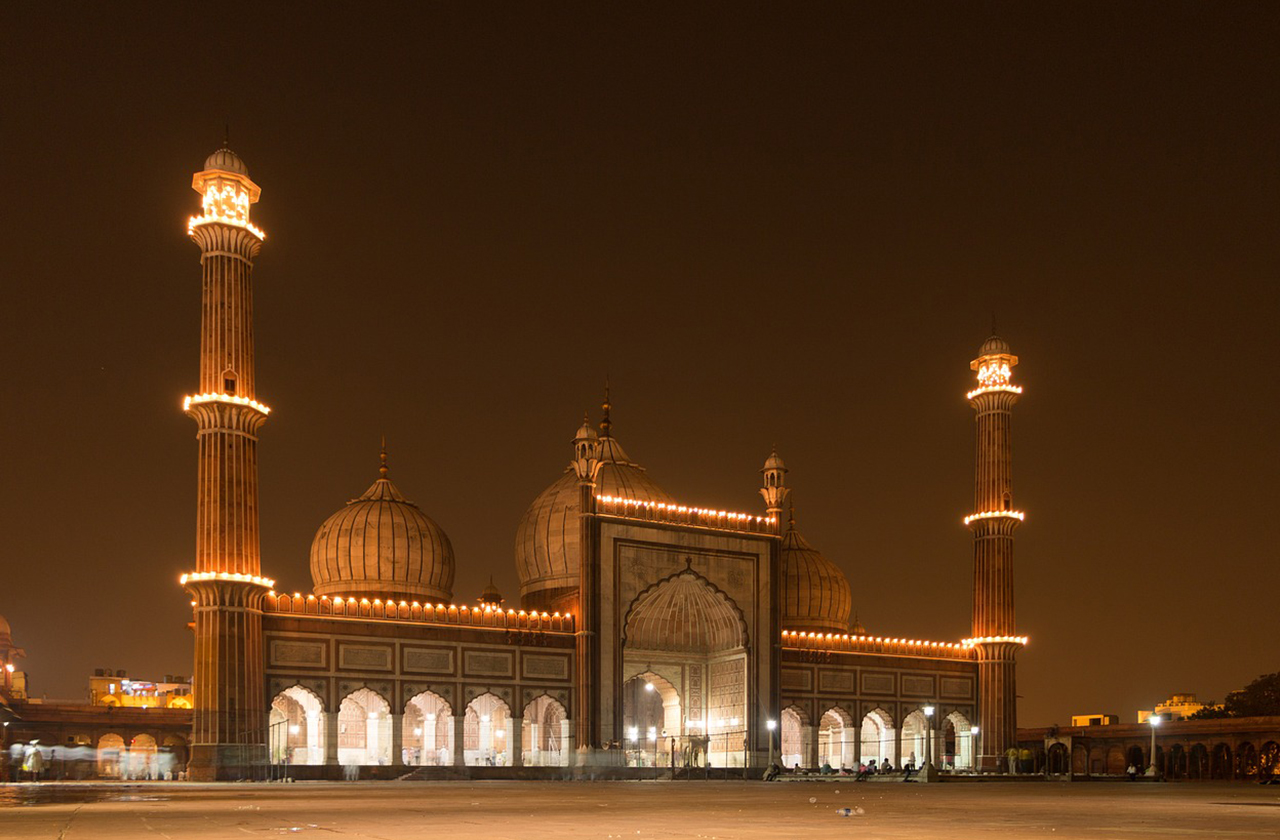
Jama Masjid Delhi: A Magnificent Marvel of Islamic Architecture
Jama Masjid, located in the heart of Old Delhi, is one of India’s most magnificent and iconic historical landmarks. This colossal mosque, also known as the “Friday Mosque,” stands as a testament to the grandeur of Mughal architecture and Islamic culture. In this article, we will provide a comprehensive overview of Jama Masjid, delving into its history, architecture, significance, and what you can expect when visiting this awe-inspiring site.
Historical Significance
Jama Masjid, which translates to “Congregational Mosque,” was commissioned by the fifth Mughal Emperor, Shah Jahan. Its construction began in 1650 and took six years to complete. The mosque was designed by the renowned architect Ustad Khalil, and its construction required the labor of over 5,000 workers.
Architectural Grandeur
Jama Masjid is a stunning example of Mughal architecture, characterized by its symmetrical design and the extensive use of red sandstone and white marble. Here are some architectural highlights:
- Red Sandstone Minarets: The mosque boasts three imposing red sandstone minarets, each standing at a height of 40 meters. These minarets not only serve as a visual spectacle but also provide a practical purpose as they were used for the call to prayer.
- Onyx and Marble Flooring: The courtyard of Jama Masjid is vast and can accommodate over 25,000 worshippers. Its floor is adorned with intricate patterns made of black and white marble, creating a mesmerizing effect.
- Bulbous Domes: The mosque features three large bulbous domes made of white marble. These domes, adorned with black stripes, add to the visual appeal of the structure.
- Main Prayer Hall: Inside the mosque, you’ll find a spacious prayer hall with a high marble pedestal where the Emperor would stand during his visits.
Religious Significance
Jama Masjid is not only a masterpiece of architecture but also holds immense religious importance for the Muslim community. It serves as a place for congregational Friday prayers and special occasions like Eid. The mosque’s serene ambiance and spiritual significance draw both worshippers and tourists alike.
Visiting Jama Masjid
When visiting Jama Masjid, there are a few essential things to keep in mind:
- Dress Modestly: As a place of worship, it’s essential to dress conservatively. Visitors are required to cover their heads and remove their shoes before entering the mosque.
- Photography: Photography is allowed, but it’s advisable to ask for permission from the caretakers or officials. The stunning architecture and panoramic views of Old Delhi from the minarets make for fantastic photo opportunities.
- Explore the Minarets: Climbing one of the minarets is a must-do. It offers a breathtaking panoramic view of Old Delhi, and the experience is truly unforgettable.
- Timings: Jama Masjid is open to visitors from morning until evening. However, it’s closed to tourists during prayer times, so be sure to check the schedule before your visit.
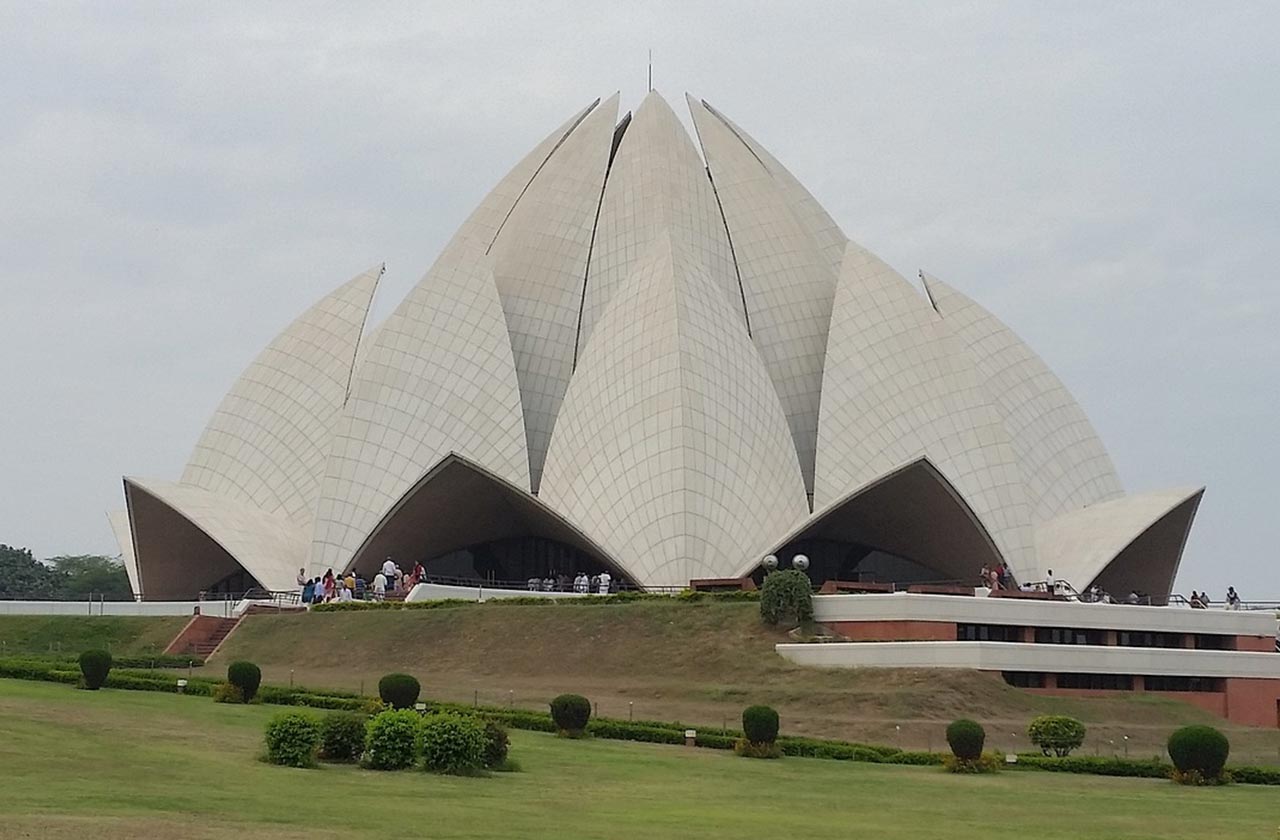
Lotus Temple a flower-inspired design
The Lotus Temple, also known as the Bahá’í House of Worship, is a place of worship for the Bahá’í Faith. It is renowned for its stunning lotus flower-inspired design and its unique approach to religion and spirituality. The temple is open to people of all faiths, making it a symbol of inclusivity and harmony.
Architectural Marvel
The Lotus Temple’s most striking feature is its lotus-shaped structure. This architectural masterpiece was designed by the Iranian-Canadian architect Fariborz Sahba. The lotus flower represents purity and beauty in various cultures and religions, making it a fitting symbol for the temple. The structure is made of white marble, and its 27 petal-like structures create the lotus shape. The temple’s pristine white exterior, against the backdrop of lush green gardens, is a sight to behold.
Spiritual Significance
As a Bahá’í House of Worship, the Lotus Temple is a place for silent meditation and reflection. It welcomes people of all faiths to come and pray or meditate, emphasizing the oneness of all religions. The Bahá’í Faith teaches the unity of God, the unity of religions, and the unity of humanity, and the Lotus Temple embodies these principles.
Open to All
One of the most unique aspects of the Lotus Temple is its policy of being open to people of all faiths, beliefs, and backgrounds. Visitors are encouraged to enter the temple, sit in silence, and meditate or pray according to their own beliefs. There are no rituals, idols, or sermons delivered within the temple. This inclusive approach has made the Lotus Temple a symbol of religious harmony.
Garden and Surroundings
The Lotus Temple is situated amidst beautifully landscaped gardens that add to its serene ambiance. The lush greenery, tranquil ponds, and well-maintained paths make it a perfect place for visitors to relax and connect with nature. The gardens also serve as a backdrop for the stunning lotus-shaped temple.
Visiting the Lotus Temple
Here’s some practical information for those planning to visit the Lotus Temple:
- Location: The Lotus Temple is located in the southern part of Delhi, near Nehru Place.
- Entry: Entry to the Lotus Temple is free of charge, and it is open to visitors of all ages.
- Timings: The temple is typically open from 9:00 AM to 5:30 PM, but it’s closed on Mondays.
- Guidelines: Visitors are expected to maintain a respectful and peaceful atmosphere within the temple. Silence is encouraged, and photography inside the prayer hall is not permitted.
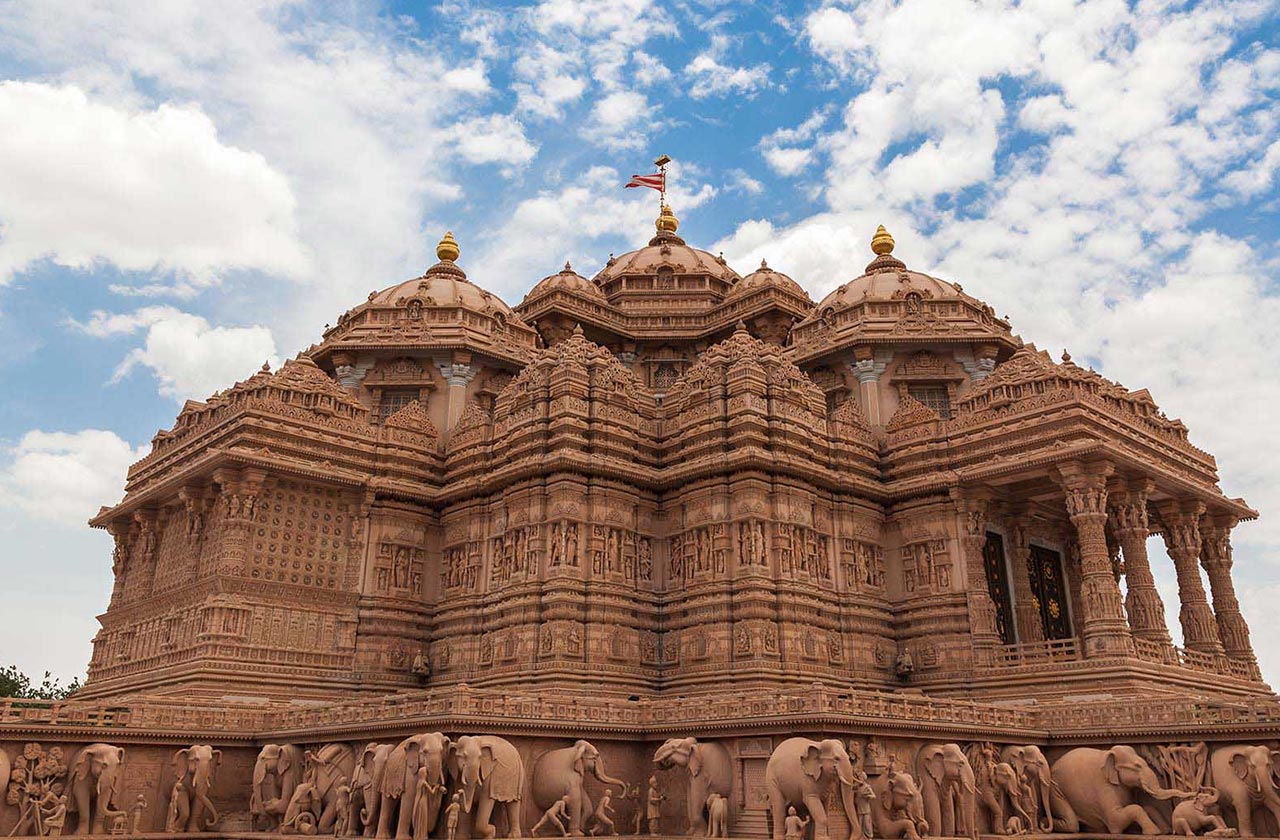
Akshardham Temple or Swaminarayan Akshardham
Akshardham, also known as the Akshardham Temple or Swaminarayan Akshardham, is a magnificent and culturally rich Hindu temple complex located in Delhi, India. This architectural marvel is a symbol of India’s rich heritage and spirituality. Here, I will provide you with comprehensive information about Akshardham in Delhi.
History and Architecture
Akshardham Temple was officially opened to the public in 2005. The temple complex was inspired and created by Pramukh Swami Maharaj, the spiritual leader of the Bochasanwasi Akshar Purushottam Swaminarayan Sanstha (BAPS), a religious organization. The complex itself showcases an impressive blend of traditional and modern architectural styles.
The main monument of Akshardham is a stunning pink sandstone structure that stands at the heart of the complex. Its intricate carvings and detailed craftsmanship are a testament to the artistic heritage of India. The central monument’s design is based on the principles of ancient Hindu architectural treatises, known as the ‘Shilpa Shastra.’
Key Attractions
- Akshardham Mandir: The main temple of Akshardham is dedicated to Bhagwan Swaminarayan and showcases his life and teachings. The idol of Swaminarayan, the presiding deity, is a major attraction. The temple is an embodiment of art, devotion, and spirituality.
- Yagnapurush Kund: This stepwell-style structure is the largest in the world. It hosts the spectacular Sahaj Anand Water Show, a multimedia presentation that narrates an ancient story of devotion and redemption.
- Exhibitions: Akshardham has several exhibition halls. The Sahaj Anand Water Show and the Yagnapurush Kund are part of the ‘Sahaj Anand Water Show’ exhibition. There’s also an ‘Abhishek Mandap’ and ‘Sahaj Anand Multimedia Water Show’ exhibition, which provide insights into Hindu philosophy, history, and values.
- Gardens and Environs: The temple complex features beautifully landscaped gardens, fountains, and water bodies that create a tranquil and serene atmosphere, providing a perfect setting for meditation and relaxation.
Timings and Visiting Details
Akshardham Temple is open to visitors on all days except Mondays. The timings are generally from 10:00 AM to 6:00 PM, with variations based on seasons and festivals. Entry to the temple is free, but there might be charges for certain exhibitions and activities within the complex. Visitors are required to adhere to a dress code and security regulations.
Significance
Akshardham stands as a testament to India’s cultural and spiritual heritage. It not only attracts pilgrims and devotees but also tourists from all around the world. The temple’s serene ambiance, architectural grandeur, and cultural significance make it a must-visit destination in Delhi.
How to Reach
Akshardham is situated in the eastern part of Delhi, near the Noida border. The nearest metro station is Akshardham Metro Station, which is well-connected to various parts of the city. If you’re traveling by car or taxi, it’s easily accessible from major areas of Delhi.
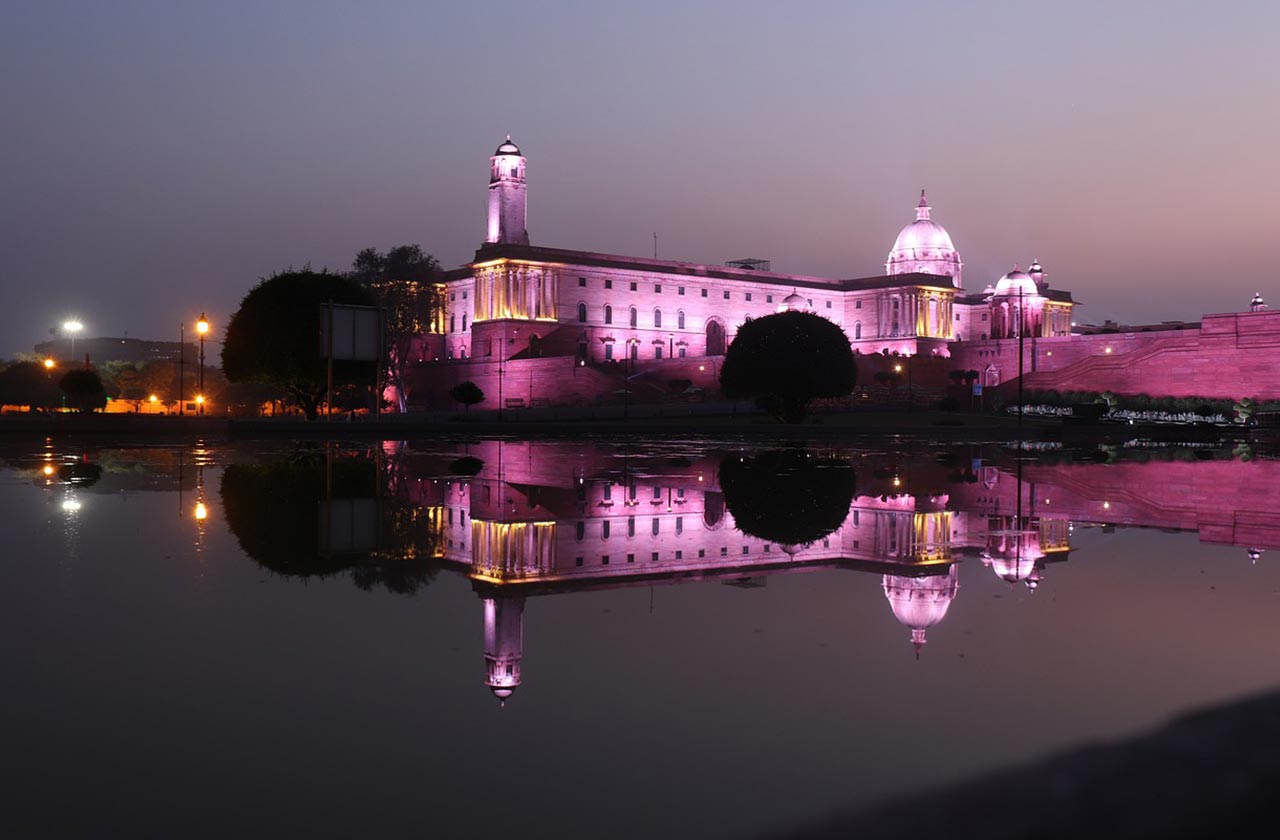
Rashtrapati Bhavan: The Presidential Residence of India
Rashtrapati Bhavan, also known as the Presidential Residence, stands as an iconic symbol of India’s democratic governance and rich history. Situated in the heart of New Delhi, this magnificent edifice is more than just the official residence of the President of India; it is a grand testament to the country’s architectural and political heritage.
Historical Significance
Rashtrapati Bhavan’s history dates back to the colonial era. Designed by renowned British architect Sir Edwin Lutyens, the construction of this sprawling presidential abode began in 1912 and was completed in 1929. Originally built as the Viceroy’s House during British rule, it became the official residence of the President of India after independence in 1950.
Architectural Marvel
The architecture of Rashtrapati Bhavan is a blend of Indian and Western styles. Lutyens, in collaboration with Indian architect B. V. Doshi, incorporated elements of Indian craftsmanship into the grandeur of Western neoclassical design. The result is a building that exudes grace, with 340 rooms spread across 4 floors, covering an area of 200,000 square feet.
Key Features
- Mughal Gardens: The Mughal Gardens, located within the Rashtrapati Bhavan complex, are a highlight. These beautifully landscaped gardens are open to the public during certain times of the year, typically in February-March.
- Durbar Hall: The Durbar Hall is where the President hosts formal functions and events. Its design features intricate woodwork, chandeliers, and a throne for the President.
- Ashoka Hall: This hall is known for its grand ceremonial functions and has a magnificent dome with the national emblem of India.
- Presidential Library: Rashtrapati Bhavan houses a vast collection of books, and the Presidential Library is a treasure trove for book enthusiasts.
- Changing of the Guard Ceremony: Visitors can witness the ceremonial changing of the guard in front of Rashtrapati Bhavan, a spectacle that takes place every Saturday.
Accessibility
While the interiors of Rashtrapati Bhavan are not typically open to the public, the surrounding Mughal Gardens and select areas are open for visitors during specific times of the year, offering a glimpse of this majestic structure. Rashtrapati Bhavan is not just a magnificent architectural marvel but also a symbol of India’s vibrant democracy. It encapsulates the country’s rich history, cultural diversity, and political heritage. As a visitor to Delhi, a view of this grand edifice is a must, offering a deep sense of India’s past and present. It’s important to check the official website of Rashtrapati Bhavan for the latest information on visiting hours and any specific guidelines for tourists. This will ensure you have a memorable and insightful experience when exploring this historic gem of Delhi.
You can book a private trip to delhi for a perfect delhi city tour
We are also available on Trip Advisor
Also Read Our Full Informative Article on Golden triangle tour

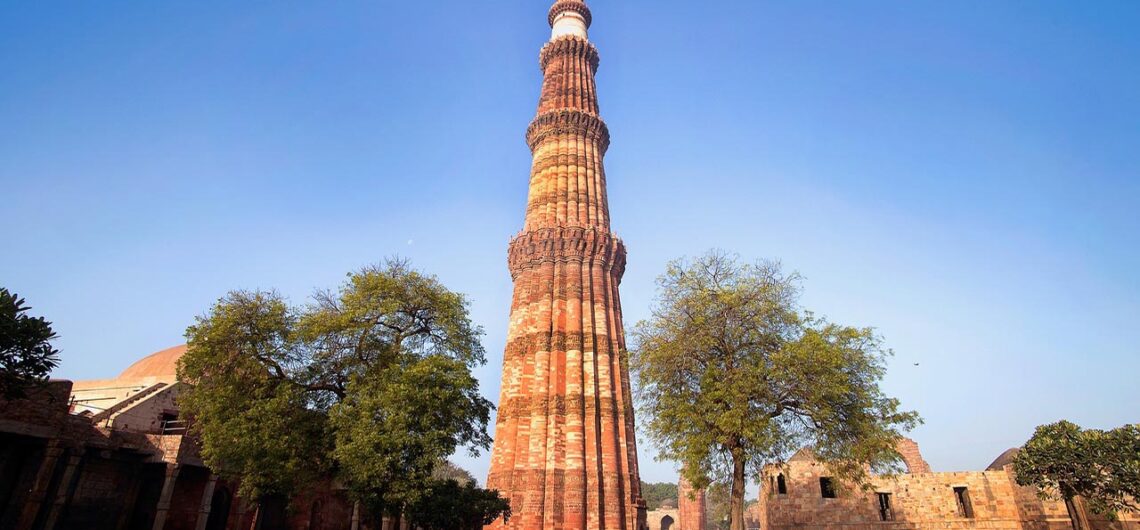
Comments